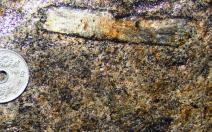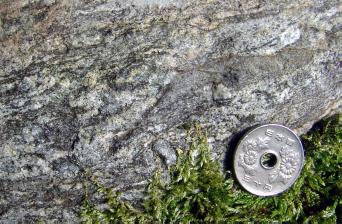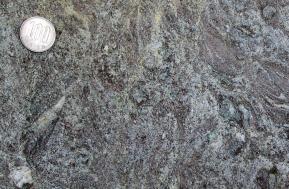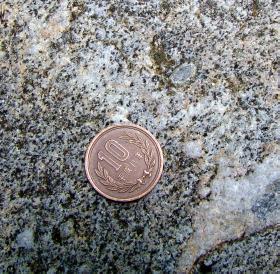Sillimanite-Cordierite Xenocrysts in S-type Tonalite, Hidaka Metamorphic Complex, Hokkaido, JapanRoberto Weinberg, Monash University, Australia Andy Tomkins, Kyle Rebryna, Monash University, Australia |
In the
Nikambetsu river in southern Hidaka
Metamorphic Complex, there is a series of outcrops of
sillimanite-cordierite tonalite with biotite rims. Two thin sections
were studied: one had retrogressed (sericitized), rounded grains of
poikilitic cordierite, in a
cordierite+orthopyroxene+garnet+muscovite+biotite tonalite,
representing a tonalite formed through melting at high grade, the other
one, from the Nikambetsu river had porphyroblasts of sillimanite in the
core, surrounded by cordierite (?) rimmed by biotite, forming an
elliptical grain like in the photographs below. The rock is thus:
(sericite+chlorite) cordierite+sillimanite+muscovite+biotite tonalite.
The cordierite around the sillimanite needs to be confirmed by probing,
and it is partly retrogressed to sericite and chlorite. Thus, many of
the sillimanite grains depicted below could represent complex grains
possibly representing the partial break down of sillimanite+biotite to
form cordierite. This page shows several outcrops with long
sillimanite rimmed by biotite and defining a lineation in the tonalite.
|
a) Pon Nikambetsu and Sarurugawa rivers: cordierite and sillimanite in tonalite
b) Sarurugawa river: sillimanite in migmatite
c) Nikambetsu river: sillimanite (possibly with cordierite) xenocrysts in tonalite



